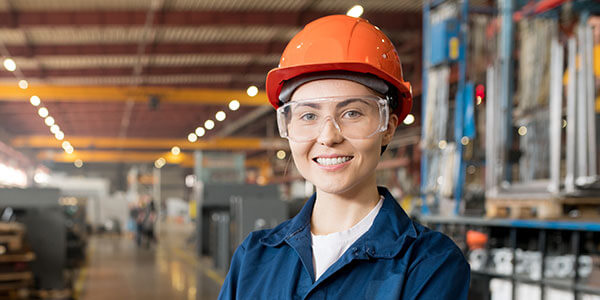The Importance of Proper Fit in Women’s PPE

Proper personal protective equipment (PPE) is essential to a safe construction site. The Occupational Health and Safety Act (OHSA) and Regulations for Construction Projects (O. Reg. 213/91) have specific guidelines for required PPE on construction sites, including eyewear, respiratory protection, head protection and gloves.
An estimated 12% of construction workers in Canada are women, and they are held to the same PPE standards as men.
However, the PPE manufacturing industry has been slower to catch up to the growing numbers of women in construction. This has left tens of thousands of women incorrectly protected from key construction site hazards, such as prolonged loud noises, burns, crushing injuries and airborne particulates.
The Challenges of Ill-Fitting PPE for Women
A 2021 Institute for Women’s Policy Research Tradeswoman’s Retention and Advancement Survey found that, of 2,635 tradeswomen and non-binary tradespeople, only 19.1% of participants said they were always provided with gloves or safety equipment in sizes that properly fit them.
Similarly, a 2015 study by the Washington State Department of Labor and Industries and the Safety and Health Investment Projects found that several participants reported experiencing injuries when using ill-fitting PPE, and that most employers didn’t provide PPE properly fitted to women’s bodies.
Traditional construction PPE is fabricated to fit men’s bodies, with larger hands and feet, harnesses that must support larger waist sizes, hard hats made to fit wider heads and more. Equipment in these larger sizes won’t fit many women, leaving them to wear ill-fitting PPE that can put them at greater risk of injury.
The Benefits of Properly Fitted Women’s PPE
Sourcing properly fitted women’s PPE not only benefits your workers, but it also can benefit your project.
Enhanced Safety and Reduced Injury Risk
When women wear ill-fitting PPE, they are at a greater risk of work-related accidents. Improperly fitted hard hats, for example, may slip off a worker’s head and cause their vision to be blocked, leading to an accident. Gloves that are too big could get caught in machinery and cause an injury.
By having PPE that’s properly fitted, women in construction are just as protected from workplace hazards as are their male counterparts wearing properly fitted PPE.
Investing in some PPE that’s specially made to fit women’s bodies is a financial outlay at first, but it’s an investment that will pay off in the long run as your jobsite accidents and injuries are reduced.
Increased Comfort and Productivity
Wearing improperly fitted PPE is like wearing clothing that is too big or too small; it’s distracting and must be adjusted often. Frequently pausing to rearrange a too-big safety vest, for example, means the worker won’t be as consistent with their work results.
Ill-fitting PPE also is uncomfortable. Workers are continually worried something is falling off or oriented incorrectly, which can distract them from their tasks and may lead to careless accidents.
With PPE that fits correctly, workers can put their equipment on each day confident it will protect them. They can focus on their tasks and keep worksite productivity high. This increased focus also makes them more likely to observe potentially hazardous situations, avoiding accidents.
Boosted Confidence and Inclusion
With women making up 12% of the construction workforce, they are still very much a minority in the industry. This can feel intimidating enough on its own, but it’s made worse when they are forced to do their jobs wearing PPE that’s too big. They may feel even more isolated, and they could be less likely to be taken seriously by their peers.
Being able to wear PPE that’s designed to fit their bodies not only feels better physically, but it can make women in construction feel as if they stand out a little less. They will look just like everyone else on the site, helping them feel better included and integrated in the worksite culture.
How to Implement Proper PPE for Women on Construction Sites
If your PPE for women could use an overhaul, here’s what you need to know.
Assess Your Current PPE
First, take inventory of the PPE you currently have on hand, and compare it to your workers. Do you have an adequate supply of PPE in a variety of sizes and types to fit everyone? Is all your PPE made for larger bodies and you’ve got workers who have equipment that doesn’t fit correctly?
Make a list of all the types of PPE that you need in various sizes. You may not need to completely purchase everything new, but taking stock of what you have is key to avoiding overbuying or buying the wrong things.
Select the Right PPE for Women
There are a growing number of PPE manufacturers that create PPE specially sized for women and non-binary construction workers, as well as for those larger-bodied men who may need specialty items.
Take some time to investigate your options, comparing your budget against what you’ll likely pay to purchase new equipment. Look at reviews from other construction firms or ask friends in the industry what companies they’d recommend.
Alternatively, consider offering workers who require specialty PPE a stipend to purchase their own equipment. That way, they can get the gear that suits them perfectly and takes the burden of sourcing every piece off your shoulders.
Train and Educate Staff
Every construction worker could use a bit of a refresher course on proper PPE use, no matter how experienced they are. Take this PPE supply update as an opportunity to host seminars on the proper use of PPE.
Your Partner in Construction Site Safety
At Medcor Canada, we work hard to be your partner in establishing and maintaining construction site safety. From safety training courses to onsite safety audits, our team can support your project so your workers stay safe and healthy and you stay on schedule and on budget. Speak with an advocate today.